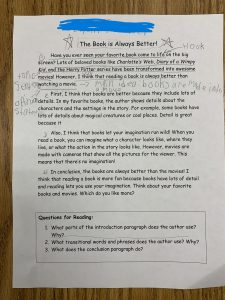What is InTASC Standard 6: Assessment
The teacher employs a variety of assessment types to track the student’s learning progress and inform instructional planning. Ongoing assessment holds teachers accountable for the quality of their instruction and empower students to achieve high standards of learning. Assessment is a reflection tool for measuring knowledge and skills that align with clear learning objectives to set the student towards success.
Artifacts for InTASC Standard 6: Assessment
Civil War Unit Assessment
Before I taught my two-week unit on the Civil War, I assessed students’ prior knowledge of the topic using a pre-assessment quiz that I designed. The pre-assessment was specially prepared to preview the central concepts that I would teach over the next two weeks, and the results helped me emphasize specific concepts and create learning objectives for the unit. At the end of the unit, I administered the same quiz as a post-assessment to measure the students’ acquired content knowledge. This helped me evaluate the effectiveness of my learning objectives, a practice that aligns with InTASC Standard #6. The purpose of the standard is to use assessment data to guide the teacher’s instruction, and these assessments helped me make important decisions about how to teach the topic of the Civil War. For instance, from my assessment data, I gathered that I needed to review certain topics in greater depth to avoid the misconceptions that arose on the summative assessment. These reflections show that I use assessments as evidence for my instruction.
(Click the link to view the quiz I designed to assess my students’ prior knowledge and growth on the subject of the Civil War: EDUC 470_032723_Civil War Assessment).
MAPS Testing Assessment Data
During my student teaching experience, my 4th grade students demonstrated their proficiency in reading on the Measures of Academic Progress (MAP) assessments. The MAP assessment is an interim growth assessment that projects the student’s preparedness for the Virginia Standards of Learning (SOL) tests. The data from spring MAP testing represented students on a matrix of high and low achievement and high and low growth. This data led my supervising teacher and I to differentiate small groups based on MAP scores. I taught reading comprehension strategies in a “bubble group” comprised of students who fell between passing and failing, and Mrs. Morgan worked with students who needed more rigorous reading instruction. This application of assessment scores shows how InTASC Standard #6 impacts my instruction. Specifically, the data showed the need for differentiation and for individual improvement goals – this ensured personalized instruction and appropriate challenges for every student.


(The first image shows the reading groups that Mrs. Morgan and I created in the first week after analyzing the MAP scores; the second image is a work sample of a reading comprehension activity I created to review opinion passages).
LETRS Phonics and Word-Reading Survey
The LETRS assessment measures the students’ knowledge of phonics patterns and letter-sound correspondences, and it includes concepts ranging from alphabet knowledge to vowel patterns to common prefixes and suffixes. I administered the LETRS assessment to five students in the early phases of my student teaching experience and uncovered interesting trends in their reading abilities. At least one student completed each section with automaticity; several others showed frustration early on and did not complete the assessment. These results helped me understand the unique struggles of individual students as well as the literacy challenge facing all 4th grade students. The LETRS assessment demonstrates how I’ve implemented InTASC Standard #6 during my student teaching experience. The LETRS assessment helped me identify students who needed explicit instruction in decoding, which further helped me consider how to incorporate reading practice during our reading block and in other subjects.
(This PDF is a copy of the LETRS assessment that I administered: LETRS-Phonics-and-Word-Reading-Survey)